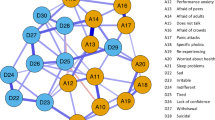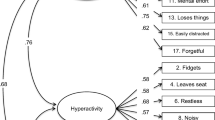Abstract
The current study used confirmatory factor analysis (CFA) to examine the factor structure of anxiety and depressive disorders in a sample of clinic-referred adolescents, aged between 12 and 18 years, for diagnoses based on parent (N = 655; male = 441) and adolescent (N = 626; male = 417) interviews. Three models were examined: a 1-factor model, with all anxiety and depressive disorders in a single factor; a DSM-based 2-factor model, with anxiety disorders in one factor, and depressive disorders in another factor; and an alternate 2-factor model, with fear related anxiety disorders in one factor, and other anxiety and depressive disorders in another factor. The findings indicated support for all three models. Also, ADHD and ODD/CD were associated with only the shared variances between the latent factors in the 2-factor models, and not their unique variance. The implications of the findings for taxonomy, comorbidity, and clinical practice are discussed.

Similar content being viewed by others
References
American Psychiatric Association. (1994). Diagnostic and statistical manual of mental disorders IV. Washington, DC: American Psychiatric Association.
American Psychiatric Association. (2000). Diagnostic and statistical manual of mental disorders – IV text revised. Washington, DC: American Psychiatric Association.
American Psychiatric Association. (2013). Diagnostic and statistical manual of mental disorders – 5. Washington, DC: American Psychiatric Association.
Angold, A., Costello, E. J., & Erkanli, A. (1999). Comorbidity. Journal of Child Psychology and Psychiatry, 40, 57–87.
Beesdo-Baum, K., Höfler, M., Gloster, A. T., Klotsche, J., Lieb, R., Beauducel, A., et al. (2009). The structure of common mental disorders: a replication study in a community sample of adolescents and young adults. International Journal of Methods in Psychiatric Research, 18, 204–220.
Brown, T. A. (2006). Confirmatory factor analysis for applied research. New York: Guilford Press.
Brown, T. A., Chorpita, B. F., & Barlow, D. H. (1998). Structured relationships among dimensions of the DSM–IV anxiety and mood disorders and dimensions of negative affect, positive affect, and autonomic arousal. Journal of Abnormal Psychology, 107, 179–192.
Burnham, K. P., & Anderson, D. R. (2004). Multimodel inference: understanding AIC and BIC in model selection. Sociological Methods & Research, 33, 261–304.
Cantwell, D. P., Lewinsohn, P. M., Rohde, P., & Seeley, J. R. (1997). Correspondence between adolescent report and parent report of psychiatric diagnostic data. Journal of the American Academy of Child and Adolescent Psychiatry, 36, 610–619.
Clark, L. A., & Watson, D. (1991). Tripartite model of anxiety and depression: psychometric evidence and taxonomic implications. Journal of Abnormal Psychology, 100, 316–336.
Clark, L. A., & Watson, D. (2006). Distress and fear disorders: an alternative empirically based taxonomy of the “mood” and “anxiety” disorders. The British Journal of Psychiatry, 189, 481–483.
Ehrenreich-May, & Bilek. (2012). The development of a transdiagnostic, cognitive behavioral group intervention for childhood anxiety disorders and co-occurring depression symptoms. Cognitive and Behavioral Practice, 19, 41–55.
Fleiss, J. L. (1981). Statistical methods for rates and proportions (2nd ed.). Wiley: New York.
Fornell, C., & Larcker, D. F. (1981). Evaluating structural equation models with unobservable variables and measurement error. Journal of Marketing Research, 18, 39–50.
Gomez, R., & Corr, P. J. (2010). Attention-Deficit/Hyperactive Disorder symptoms: associations with Gray’s and Tellegen’s models of personality. Personality and Individual Difference, 49, 902–906.
Higa-McMillan, C. K., Smith, R. L., Chorpita, B. K., & Hayashi, K. (2008). Common and unique factors associated with DSM-IV-TR internalizing disorders in children. Journal of Abnormal Child Psychology, 36, 1279–1288.
Hu, L. T., & Bentler, P. M. (1998). Fit indices in covariance structure modeling: sensitivity to underparameterized model misspecification. Psychological Methods, 3, 424–453.
Kashani, J. H., & Orvaschel, H. (1990). A community study of anxiety in children and adolescents. The American Journal of Psychiatry, 147, 313–318.
Kessler, R. C., Chiu, W. T., Demler, O., & Walters, E. E. (2005). Prevalence, severity, and comorbidity of 12-month DSM-IVdisorders in the National Comorbidity Survey Replication. Archives of General Psychiatry, 62, 617–627.
Kovacs, M., & Devlin, B. (1998). Internalizing disorders in childhood. Journal of Child Psycholgy and Psychiatry, 39, 47–63.
Krueger, R. F., & Markon, K. E. (2006). Reinterpreting comorbidity: a model-based approach to understanding and classifying psychopathology. Annual Review of Clinical Psychology, 2, 111–133.
Krueger, R. F. (1999). The structure of common mental disorders. Archives of General Psychiatry, 56, 921–926.
Krueger, R. F., & Finger, M. S. (2001). Using item response theory to understand comorbidity among anxiety and unipolar mood disorders. Psychological Assessment, 13, 140–151.
Krueger, R. F., Caspi, A., Moffitt, T. E., & Silva, P. A. (1998). The structure and stability of common mental disorders (DSM–III–R): a longitudinal– epidemiological study. Journal of Abnormal Psychology, 107, 216–227.
Lahey, B. B., Applegate, B., Waldman, I. D., Loft, J. D., Hankin, B. L., & Rick, J. (2004). The structure of child and adolescent psychopathology: generating new hypotheses. Journal of Abnormal Psychology, 113, 358–385.
Lahey, B. B., Rathouz, P. J., Van Hulle, C., Urbano, R. C., Krueger, R. F., Applegate, B., et al. (2008). Testing structural models of DSM-IV symptoms of common forms of child and adolescent psychopathology. Journal of Abnormal Child Psychology, 36, 187–206.
Lewinsohn, P. M., Zinbarg, R., Seeley, J. R., Lewinsohn, M., & Sack, W. H. (1997). Lifetime comorbidity among anxiety disorders and between anxiety disorders and other mental disorders in adolescents. Journal of Anxiety Disorders, 11, 377–394.
Lewinshon, P. M., Rohde, P., Seeley, J. R., & Hops, H. (1991). Comorbidity of unipolar depression. I: major depression with dysthymia. Journal of Abnormal Psychology, 100, 205–213.
McEvoy, P. M., Nathan, P., & Norton, P. J. (2009). Efficacy of transdiagnostic treatments: a review of published outcome studies and future research directions. Journal of Cognitive Psychotherapy, 23, 20–33.
McGlinchey, J. B., & Zimmerman, M. (2007). Examining dimensional representation of depression and anxiety disorders’ comorbidity in psychiatric outpatients with item response modeling. Journal of Abnormal Psychology, 116, 464–474.
Mineka, S., Watson, D., & Clark, L. A. (1998). Comorbidity of anxiety and unipolar mood disorders. Annual Review of Psychology, 49, 377–412.
Muthen, L. K., & Muthen, B. O. (2010). Mplus user’s guide (6th ed.). Los Angeles: Muthen & Muthen.
Nigg, J. T., Oliver, J. P., Blaskey, L. G., Huang-Pollock, C. L., Willcutt, E. G., Hinshaw, S. P., et al. (2002). Big Five dimensions and ADHD symptoms: links between personality traits and clinical symptoms. Journal of Personality and Social Psychology, 83, 451–469.
Seeley, J. R., Kosty, D. B., Farmer, R. F., & Lewinsohn, P. M. (2011). The modeling of internalizing disorders on the basis of patterns of lifetime comorbidity: associations with psychosocial functioning and psychiatric disorders among first-degree relatives. Journal of Abnormal Psychology, 120, 308–321.
Silverman, W. K., & Albano, A. M. (1996). Anxiety disorders interview schedule for children for DSM-IV, child and parent versions. San Antonio: Psychological Corporation.
Silverman, W. K., Saavedra, L. M., & Pina, A. A. (2001). Test–retest reliability ofanxiety symptoms and diagnoses with the Anxiety Disorders Interview Schedule for DSM-IV: child and parent versions. Journal of the American Academy of Child and Adolescent Psychiatry, 40, 937–944.
Slade, T., & Watson, D. (2006). The structure of common DSM–IV and ICD–10 mental disorders in the Australian general population. Psychological Medicine, 36, 1593–1600.
Trosper, S., Whitton, S. W., Brown, T. A., & Pincus, D. B. (2012). Understanding the latent structure of the emotional disorders in children and adolescents. Journal of Abnormal Child Psychology, 40, 621–632.
Vollebergh, W. A. M., Iedema, J., Bijl, R. V., de Graaf, R., Smit, F., & Ormel, J. (2001). The structure and stability of common mental disorders: the NEMESIS study. Archives of General Psychiatry, 58, 597–603.
Watson, D. (2005). Rethinking the mood and anxiety disorders: a quantitative hierarchical model for DSM-V. Journal of Abnormal Psychology, 114, 522–536.
Watson, D., Clark, L. A., & Carey, G. (1988). Positive and negative affectivity and their relation to anxiety and depressive disorders. Journal of Abnormal Psychology, 97, 346–353.
Wittchen, H.-U., Lieb, R., Schuster, P., & Oldehinkel, A. J. (1999). When is onset? Investigations into early developmental stages of anxiety and depressive disorders. In J. L. Rapoport (Ed.), Childhood onset of ‘adult’ psychopathology, clinical and research advances (pp. 259–302). Washington, DC: American Psychiatric Press.
Author information
Authors and Affiliations
Corresponding author
Rights and permissions
About this article
Cite this article
Gomez, R., Vance, A. & Gomez, R.M. The Factor Structure of Anxiety and Depressive Disorders in a Sample of Clinic-Referred Adolescents. J Abnorm Child Psychol 42, 321–332 (2014). https://doi.org/10.1007/s10802-013-9787-z
Published:
Issue Date:
DOI: https://doi.org/10.1007/s10802-013-9787-z




